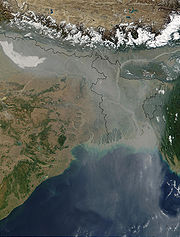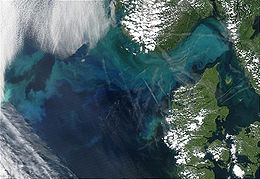
Cloud condensation nuclei
Encyclopedia

Micrometre
A micrometer , is by definition 1×10-6 of a meter .In plain English, it means one-millionth of a meter . Its unit symbol in the International System of Units is μm...
, or 1/100 th the size of a cloud
Cloud
A cloud is a visible mass of liquid droplets or frozen crystals made of water and/or various chemicals suspended in the atmosphere above the surface of a planetary body. They are also known as aerosols. Clouds in Earth's atmosphere are studied in the cloud physics branch of meteorology...
droplet http://apollo.lsc.vsc.edu/classes/met130/notes/chapter5/ccn.html) about which cloud droplets coalesce
Coalescence (meteorology)
Coalescence is the process by which two or more droplets, bubbles or particles merge during contact to form a single daughter droplet, bubble or particle. It can take place in many processes, ranging from meteorology to astrophysics. For example, it is both inve formation of raindrops as well as...
. Water requires a non-gaseous surface to make the transition from a vapour to a liquid
Liquid
Liquid is one of the three classical states of matter . Like a gas, a liquid is able to flow and take the shape of a container. Some liquids resist compression, while others can be compressed. Unlike a gas, a liquid does not disperse to fill every space of a container, and maintains a fairly...
. In the atmosphere, this surface presents itself as tiny solid or liquid particles called CCNs. When no CCNs are present, water vapour can be supercooled below 0 °C (32 °F) before droplets spontaneously form (this is the basis of the cloud chamber
Cloud chamber
The cloud chamber, also known as the Wilson chamber, is a particle detector used for detecting ionizing radiation. In its most basic form, a cloud chamber is a sealed environment containing a supersaturated vapor of water or alcohol. When a charged particle interacts with the mixture, it ionizes it...
for detecting subatomic particles). In above freezing temperatures the air would have to be supersaturated to around 400% before the droplets could form.
The concept of cloud condensation nuclei has led to the idea of cloud seeding
Cloud seeding
Cloud seeding, a form of intentional weather modification, is the attempt to change the amount or type of precipitation that falls from clouds, by dispersing substances into the air that serve as cloud condensation or ice nuclei, which alter the microphysical processes within the cloud...
, that tries to encourage rainfall by seeding the air with condensation nuclei. It has further been suggested that creating such nuclei could be used for marine cloud brightening, a geoengineering
Geoengineering
The concept of Geoengineering refers to the deliberate large-scale engineering and manipulation of the planetary environment to combat or counteract anthropogenic changes in atmospheric chemistry The Intergovernmental Panel on Climate Change concluded in 2007 that geoengineering options, such...
technique.
Size, abundance, and composition
A typical raindrop is about 2 mm in diameter, a typical cloud droplet is on the order of 0.02 mm, and a typical cloud condensation nucleus (aerosol) is on the order of 0.0001 mm or 0.1 micrometer or greater in diameter. The number of cloud condensation nuclei in the air can be measured and ranges between around 100 to 1000 per cubic centimetre. The total mass of CCNs injected into the atmosphere has been estimated at 2x1012 kg over a year's time. Large concentrations of particulates are also responsible for hazeHaze
Haze is traditionally an atmospheric phenomenon where dust, smoke and other dry particles obscure the clarity of the sky. The World Meteorological Organization manual of codes includes a classification of horizontal obscuration into categories of fog, ice fog, steam fog, mist, haze, smoke, volcanic...
in areas with lower humidity
Humidity
Humidity is a term for the amount of water vapor in the air, and can refer to any one of several measurements of humidity. Formally, humid air is not "moist air" but a mixture of water vapor and other constituents of air, and humidity is defined in terms of the water content of this mixture,...
. This dry haze also has an effect on climate by either absorbing or reflecting radiation (see albedo
Albedo
Albedo , or reflection coefficient, is the diffuse reflectivity or reflecting power of a surface. It is defined as the ratio of reflected radiation from the surface to incident radiation upon it...
).
There are many different types of atmospheric particulates
Particulates
Particulates – also known as particulate matter , suspended particulate matter , fine particles, and soot – are tiny subdivisions of solid matter suspended in a gas or liquid. In contrast, aerosol refers to particles and/or liquid droplets and the gas together. Sources of particulate matter can be...
that can act as CCN. The particles may be composed of dust or clay
Clay
Clay is a general term including many combinations of one or more clay minerals with traces of metal oxides and organic matter. Geologic clay deposits are mostly composed of phyllosilicate minerals containing variable amounts of water trapped in the mineral structure.- Formation :Clay minerals...
, soot
Soot
Soot is a general term that refers to impure carbon particles resulting from the incomplete combustion of a hydrocarbon. It is more properly restricted to the product of the gas-phase combustion process but is commonly extended to include the residual pyrolyzed fuel particles such as cenospheres,...
or black carbon from grassland or forest fires, sea salt from ocean wave spray, soot from factory smokestacks or internal combustion engines, sulfate
Sulfate
In inorganic chemistry, a sulfate is a salt of sulfuric acid.-Chemical properties:...
from volcanic activity, phytoplankton
Phytoplankton
Phytoplankton are the autotrophic component of the plankton community. The name comes from the Greek words φυτόν , meaning "plant", and πλαγκτός , meaning "wanderer" or "drifter". Most phytoplankton are too small to be individually seen with the unaided eye...
or the oxidation of sulfur dioxide
Sulfur dioxide
Sulfur dioxide is the chemical compound with the formula . It is released by volcanoes and in various industrial processes. Since coal and petroleum often contain sulfur compounds, their combustion generates sulfur dioxide unless the sulfur compounds are removed before burning the fuel...
and secondary organic matter formed by the oxidation of VOCs
Volatile organic compound
Volatile organic compounds are organic chemicals that have a high vapor pressure at ordinary, room-temperature conditions. Their high vapor pressure results from a low boiling point, which causes large numbers of molecules to evaporate or sublimate from the liquid or solid form of the compound and...
. The ability of these different types of particles to form cloud droplets varies according to their size and also their exact composition, as the hygroscopic properties of these different constituents are very different. Sulfate and sea salt, for instance, readily absorb water whereas soot, organic carbon and mineral particles do not. This is made even more complicated by the fact that many of the chemical species may be mixed within the particles (in particular the sulfate and organic carbon). Additionally, while some particles (such as soot and minerals) do not make very good CCN, they do act as very good ice nuclei in colder parts of the atmosphere.
The number and type of CCNs can affect the lifetimes and radiative properties of cloud
Cloud
A cloud is a visible mass of liquid droplets or frozen crystals made of water and/or various chemicals suspended in the atmosphere above the surface of a planetary body. They are also known as aerosols. Clouds in Earth's atmosphere are studied in the cloud physics branch of meteorology...
s as well as the amount and hence have an influence on climate change
Climate change
Climate change is a significant and lasting change in the statistical distribution of weather patterns over periods ranging from decades to millions of years. It may be a change in average weather conditions or the distribution of events around that average...
http://www.agu.org/revgeophys/rasmus00/node26.html http://www.grida.no/climate/ipcc_tar/wg1/181.htm; the details of this are still not well understood but are the subject of research. There is also speculation that solar variation
Solar variation
Solar variation is the change in the amount of radiation emitted by the Sun and in its spectral distribution over years to millennia. These variations have periodic components, the main one being the approximately 11-year solar cycle . The changes also have aperiodic fluctuations...
may affect cloud properties via CCNs, and hence affect climate.

Phytoplankton role
Sulfate aerosol (SO42- and methanesulfonic acidMethanesulfonic acid
Methanesulfonic acid is a colorless liquid with the chemical formula CH3SO3H. It is the simplest of the alkylsulfonic acids. Salts and esters of methanesulfonic acid are known as mesylates. Methanesulfonic acid is used as an acid catalyst in organic reactions because it is non-volatile, strong acid...
droplets) act as CCNs. These sulfate aerosols form partly from the dimethyl sulfide
Dimethyl sulfide
Dimethyl sulfide or methylthiomethane is an organosulfur compound with the formula 2S. Dimethyl sulfide is a water-insoluble flammable liquid that boils at and has a characteristic disagreeable odor. It is a component of the smell produced from cooking of certain vegetables, notably maize,...
(DMS) produced by phytoplankton in the open ocean. Large algal bloom
Algal bloom
An algal bloom is a rapid increase or accumulation in the population of algae in an aquatic system. Algal blooms may occur in freshwater as well as marine environments. Typically, only one or a small number of phytoplankton species are involved, and some blooms may be recognized by discoloration...
s in ocean surface waters occur in a wide range of latitudes and no doubt contribute considerable DMS into the atmosphere to act as nuclei. The idea that an increase in global temperature would also increase phytoplankton activity and therefore CCN numbers was seen as a possible natural phenomenon that would counteract climate change
Climate change
Climate change is a significant and lasting change in the statistical distribution of weather patterns over periods ranging from decades to millions of years. It may be a change in average weather conditions or the distribution of events around that average...
. An increase of phytoplankton has been observed by scientists in certain areas but the causes are unclear. http://www.int-res.com/articles/meps2004/268/m268p031.pdf http://www.int-res.com/abstracts/meps/v157/p39-52/ http://www.sesame-ip.eu/doc/Estuaries_Coasts.pdf
A counter-hypothesis is advanced in The Revenge of Gaia
The Revenge of Gaia
The Revenge of Gaia: Why the Earth is Fighting Back – and How we Can Still Save Humanity is a book by James Lovelock.- External links :* The Revenge of Gaia * , edited extract from The Guardian, 24 March 2006...
, the book by James Lovelock
James Lovelock
James Lovelock, CH, CBE, FRS is an independent scientist, environmentalist and futurologist who lives in Devon, England. He is best known for proposing the Gaia hypothesis, which postulates that the biosphere is a self-regulating entity with the capacity to keep our planet healthy by controlling...
. Warming oceans are likely to become stratified
Stratification (water)
Water stratification occurs when water masses with different properties - salinity , oxygenation , density , temperature - form layers that act as barriers to water mixing...
, with most ocean nutrients trapped in the cold bottom layers while most of the light needed for photosynthesis
Photosynthesis
Photosynthesis is a chemical process that converts carbon dioxide into organic compounds, especially sugars, using the energy from sunlight. Photosynthesis occurs in plants, algae, and many species of bacteria, but not in archaea. Photosynthetic organisms are called photoautotrophs, since they can...
in the warm top layer. Under this scenario, deprived of nutrients, marine phytoplankton would decline, as would sulfate cloud condensation nuclei, and the high albedo
Albedo
Albedo , or reflection coefficient, is the diffuse reflectivity or reflecting power of a surface. It is defined as the ratio of reflected radiation from the surface to incident radiation upon it...
associated with low clouds. This is known as the CLAW hypothesis http://www.atmosphere.mpg.de/enid/d9c96c048fb91779d24aedea85192a99,0/3__Gases_from_phytoplankton/-_GAIA_and_CLAW_1w1.html (named after the authors' initials of a 1987 Nature paper) but no conclusive evidence to support this has yet been reported.

